International Environmental Law: GMO Trade Regulations Analysis
VerifiedAdded on 2021/05/31
|18
|4788
|68
Report
AI Summary
This report delves into the realm of international environmental law, specifically focusing on the trade regulations of Genetically Modified Organisms (GMOs) and their profound impact on developing countries. It begins with an introduction that outlines the background, aims, objectives, and research questions, setting the stage for a comprehensive analysis. A thorough literature review explores the concept of GMO trade regulation, examining the benefits and risks associated with GMO crops, the rationale behind regulations, and their effects on developing nations. The research methodology section details the research philosophy, logic, and data collection methods employed. The report concludes by synthesizing the findings, providing a nuanced understanding of the complex interplay between GMO trade regulations and the economic landscape of developing countries. The report discusses the importance of GMOs for food security and the challenges faced in their regulation and implementation, with insights into the role of the Convention on Biological Diversity and the Cartagena Protocol on Biosafety. It emphasizes the need for science-based policies to promote GM crops and address the concerns of the public regarding health, ethical, and environmental considerations.
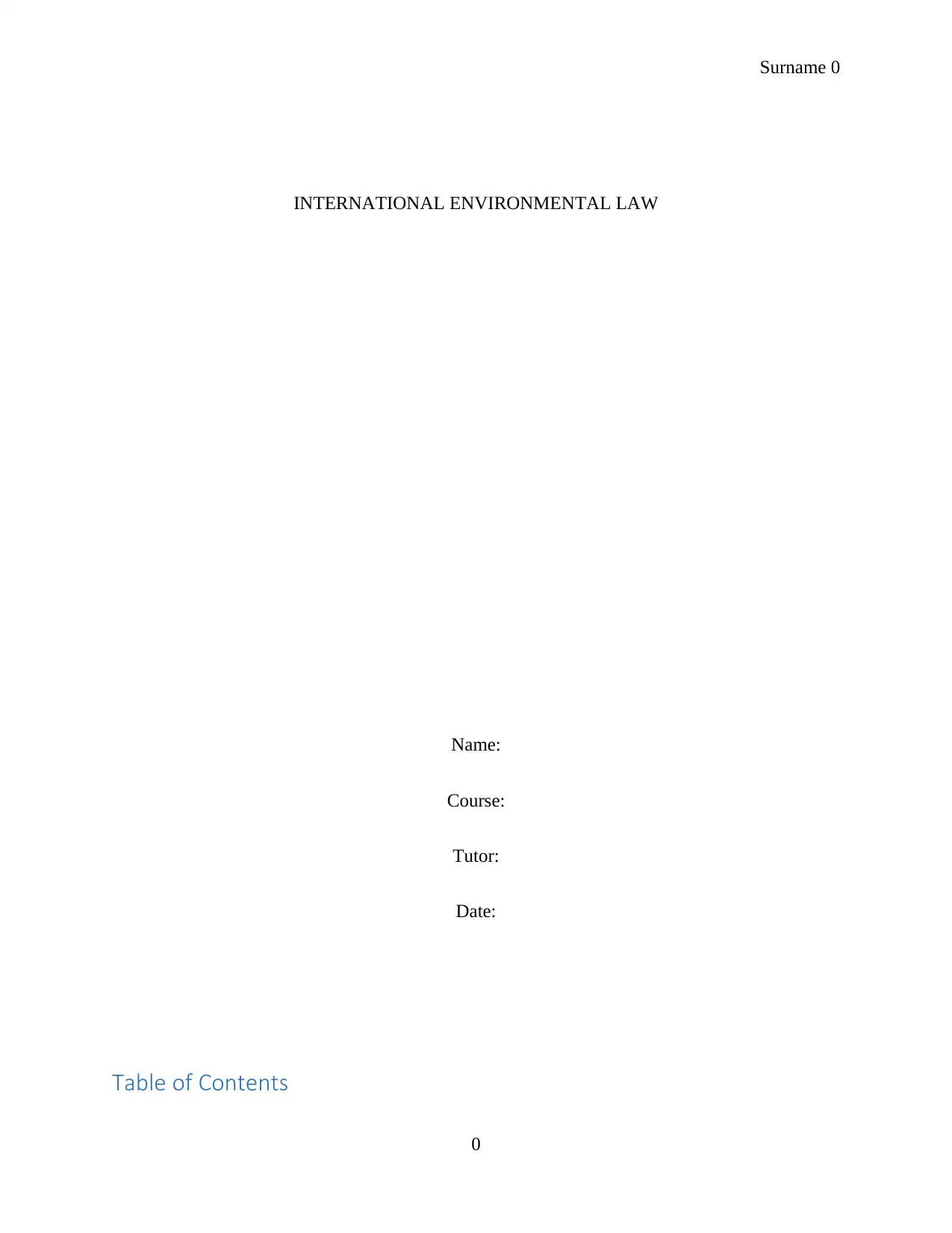
Surname 0
INTERNATIONAL ENVIRONMENTAL LAW
Name:
Course:
Tutor:
Date:
Table of Contents
0
INTERNATIONAL ENVIRONMENTAL LAW
Name:
Course:
Tutor:
Date:
Table of Contents
0
Paraphrase This Document
Need a fresh take? Get an instant paraphrase of this document with our AI Paraphraser
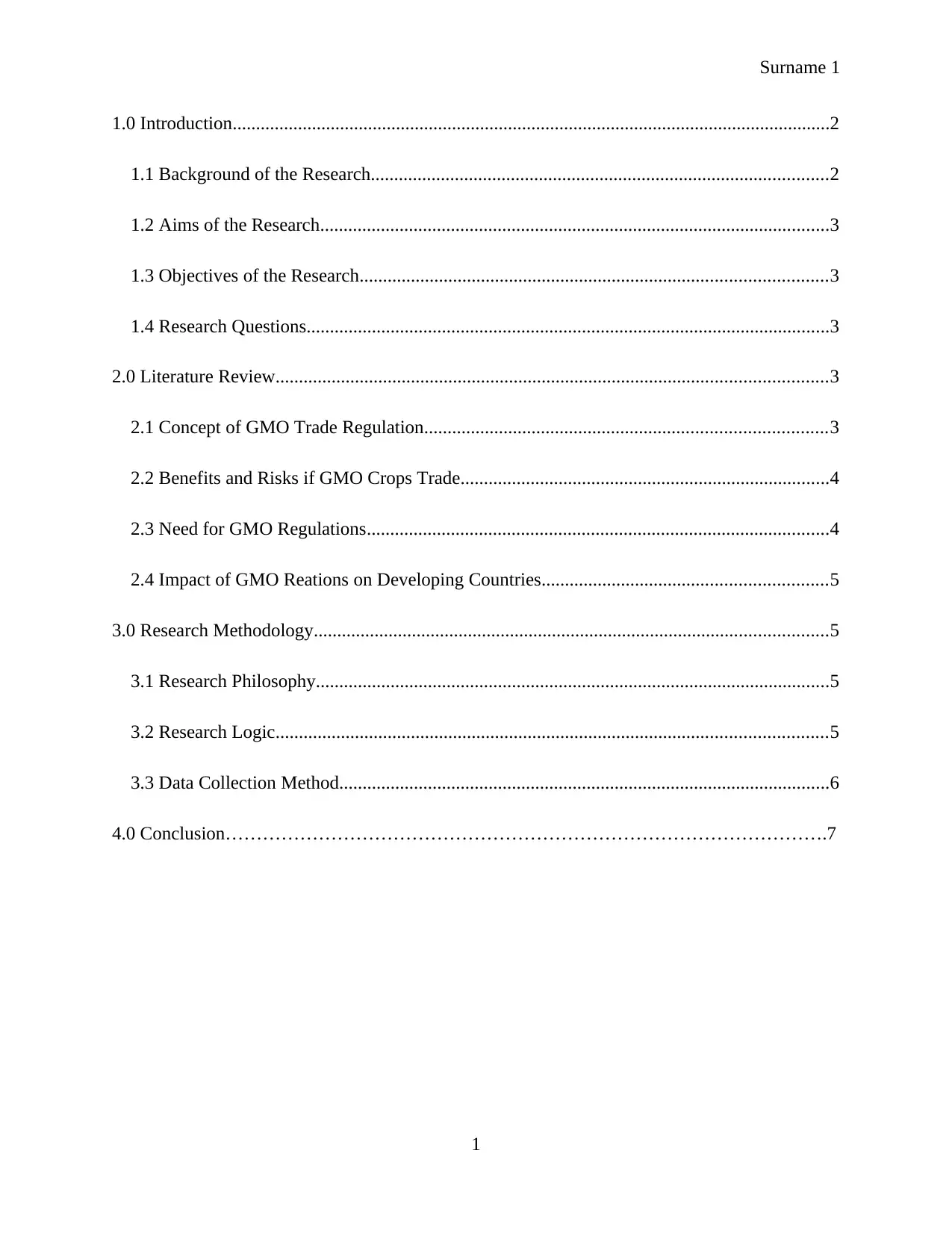
Surname 1
1.0 Introduction................................................................................................................................2
1.1 Background of the Research..................................................................................................2
1.2 Aims of the Research.............................................................................................................3
1.3 Objectives of the Research....................................................................................................3
1.4 Research Questions................................................................................................................3
2.0 Literature Review......................................................................................................................3
2.1 Concept of GMO Trade Regulation......................................................................................3
2.2 Benefits and Risks if GMO Crops Trade...............................................................................4
2.3 Need for GMO Regulations...................................................................................................4
2.4 Impact of GMO Reations on Developing Countries.............................................................5
3.0 Research Methodology..............................................................................................................5
3.1 Research Philosophy..............................................................................................................5
3.2 Research Logic......................................................................................................................5
3.3 Data Collection Method.........................................................................................................6
4.0 Conclusion…………………………………………………………………………………….7
1
1.0 Introduction................................................................................................................................2
1.1 Background of the Research..................................................................................................2
1.2 Aims of the Research.............................................................................................................3
1.3 Objectives of the Research....................................................................................................3
1.4 Research Questions................................................................................................................3
2.0 Literature Review......................................................................................................................3
2.1 Concept of GMO Trade Regulation......................................................................................3
2.2 Benefits and Risks if GMO Crops Trade...............................................................................4
2.3 Need for GMO Regulations...................................................................................................4
2.4 Impact of GMO Reations on Developing Countries.............................................................5
3.0 Research Methodology..............................................................................................................5
3.1 Research Philosophy..............................................................................................................5
3.2 Research Logic......................................................................................................................5
3.3 Data Collection Method.........................................................................................................6
4.0 Conclusion…………………………………………………………………………………….7
1
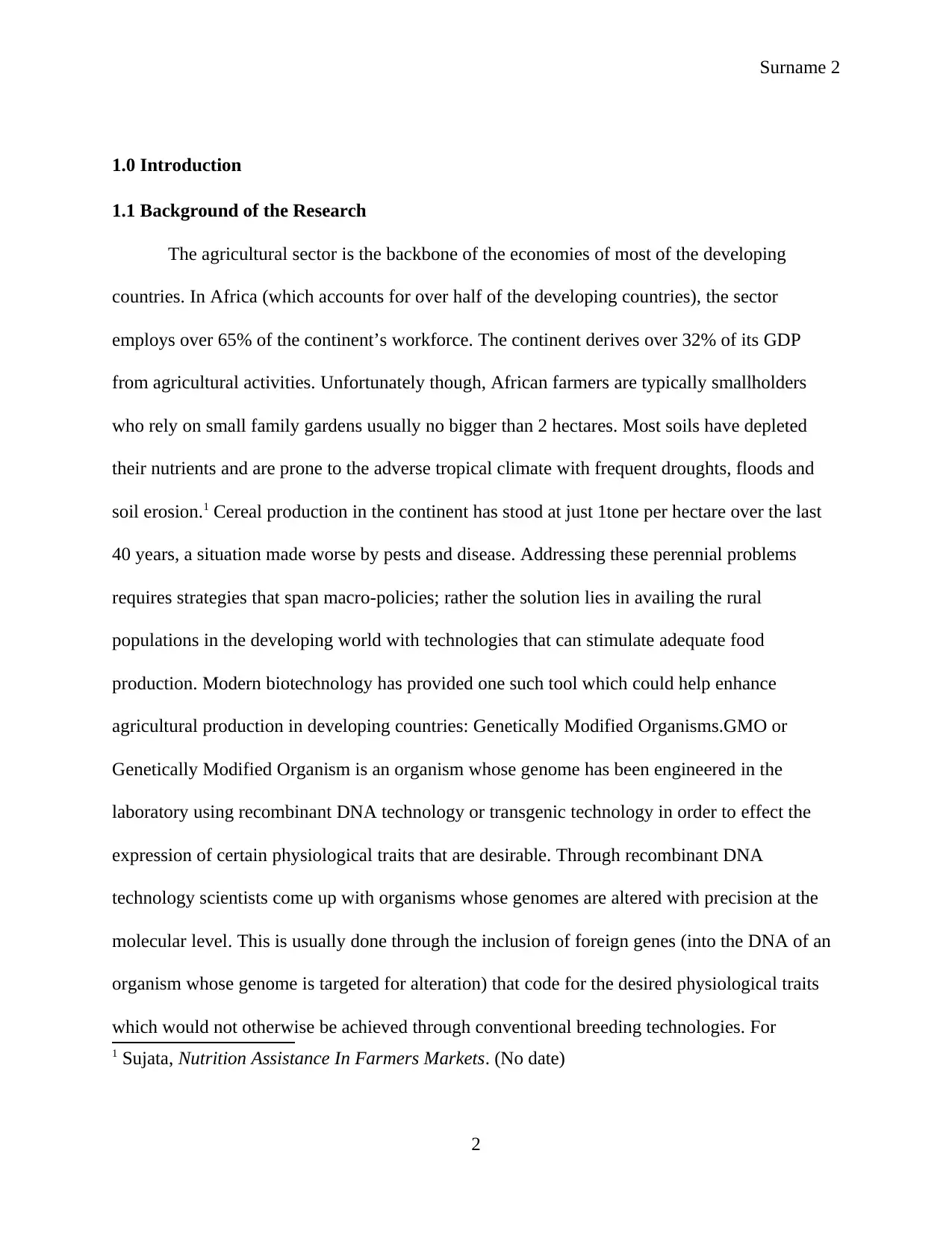
Surname 2
1.0 Introduction
1.1 Background of the Research
The agricultural sector is the backbone of the economies of most of the developing
countries. In Africa (which accounts for over half of the developing countries), the sector
employs over 65% of the continent’s workforce. The continent derives over 32% of its GDP
from agricultural activities. Unfortunately though, African farmers are typically smallholders
who rely on small family gardens usually no bigger than 2 hectares. Most soils have depleted
their nutrients and are prone to the adverse tropical climate with frequent droughts, floods and
soil erosion.1 Cereal production in the continent has stood at just 1tone per hectare over the last
40 years, a situation made worse by pests and disease. Addressing these perennial problems
requires strategies that span macro-policies; rather the solution lies in availing the rural
populations in the developing world with technologies that can stimulate adequate food
production. Modern biotechnology has provided one such tool which could help enhance
agricultural production in developing countries: Genetically Modified Organisms.GMO or
Genetically Modified Organism is an organism whose genome has been engineered in the
laboratory using recombinant DNA technology or transgenic technology in order to effect the
expression of certain physiological traits that are desirable. Through recombinant DNA
technology scientists come up with organisms whose genomes are altered with precision at the
molecular level. This is usually done through the inclusion of foreign genes (into the DNA of an
organism whose genome is targeted for alteration) that code for the desired physiological traits
which would not otherwise be achieved through conventional breeding technologies. For
1 Sujata, Nutrition Assistance In Farmers Markets. (No date)
2
1.0 Introduction
1.1 Background of the Research
The agricultural sector is the backbone of the economies of most of the developing
countries. In Africa (which accounts for over half of the developing countries), the sector
employs over 65% of the continent’s workforce. The continent derives over 32% of its GDP
from agricultural activities. Unfortunately though, African farmers are typically smallholders
who rely on small family gardens usually no bigger than 2 hectares. Most soils have depleted
their nutrients and are prone to the adverse tropical climate with frequent droughts, floods and
soil erosion.1 Cereal production in the continent has stood at just 1tone per hectare over the last
40 years, a situation made worse by pests and disease. Addressing these perennial problems
requires strategies that span macro-policies; rather the solution lies in availing the rural
populations in the developing world with technologies that can stimulate adequate food
production. Modern biotechnology has provided one such tool which could help enhance
agricultural production in developing countries: Genetically Modified Organisms.GMO or
Genetically Modified Organism is an organism whose genome has been engineered in the
laboratory using recombinant DNA technology or transgenic technology in order to effect the
expression of certain physiological traits that are desirable. Through recombinant DNA
technology scientists come up with organisms whose genomes are altered with precision at the
molecular level. This is usually done through the inclusion of foreign genes (into the DNA of an
organism whose genome is targeted for alteration) that code for the desired physiological traits
which would not otherwise be achieved through conventional breeding technologies. For
1 Sujata, Nutrition Assistance In Farmers Markets. (No date)
2
⊘ This is a preview!⊘
Do you want full access?
Subscribe today to unlock all pages.

Trusted by 1+ million students worldwide
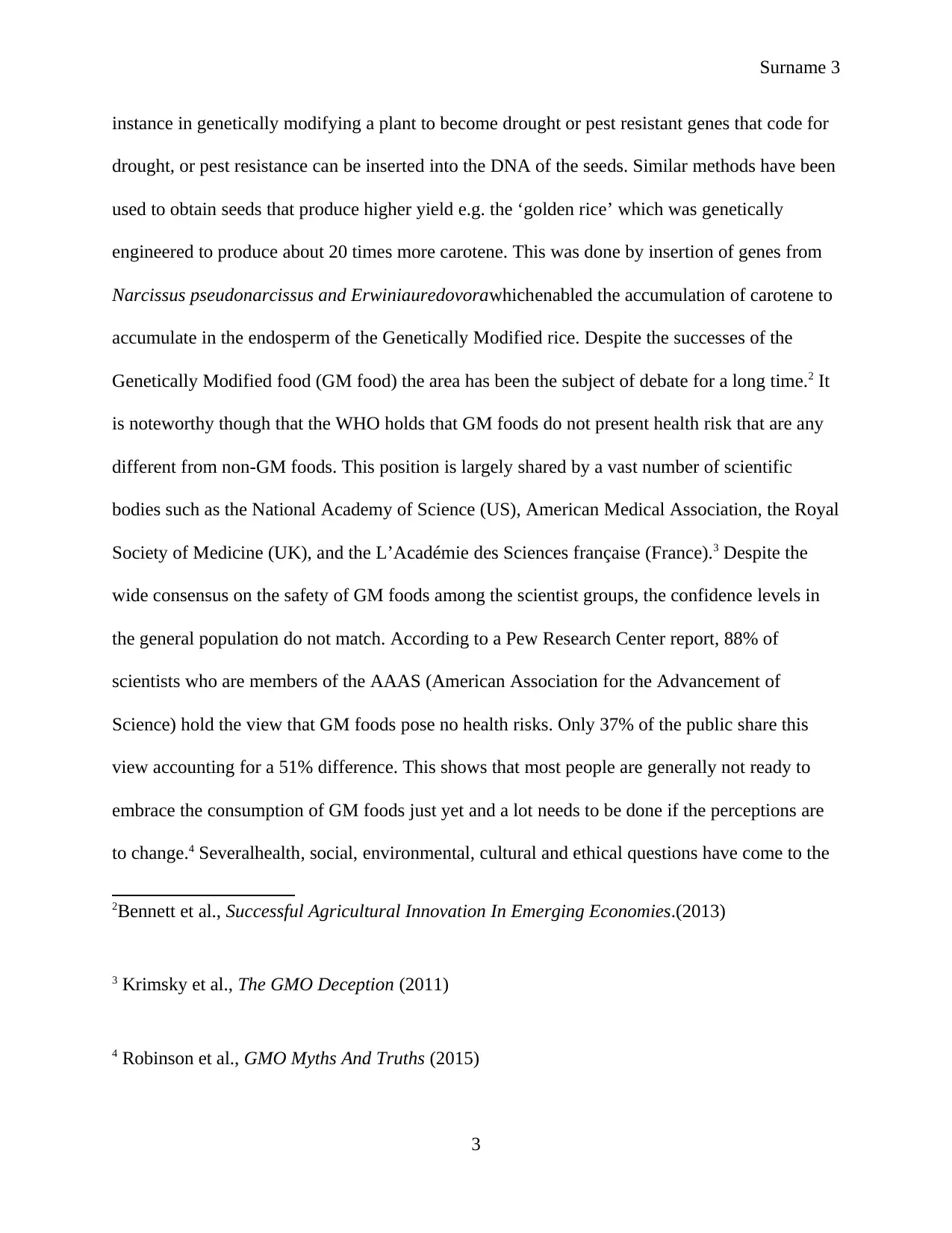
Surname 3
instance in genetically modifying a plant to become drought or pest resistant genes that code for
drought, or pest resistance can be inserted into the DNA of the seeds. Similar methods have been
used to obtain seeds that produce higher yield e.g. the ‘golden rice’ which was genetically
engineered to produce about 20 times more carotene. This was done by insertion of genes from
Narcissus pseudonarcissus and Erwiniauredovorawhichenabled the accumulation of carotene to
accumulate in the endosperm of the Genetically Modified rice. Despite the successes of the
Genetically Modified food (GM food) the area has been the subject of debate for a long time.2 It
is noteworthy though that the WHO holds that GM foods do not present health risk that are any
different from non-GM foods. This position is largely shared by a vast number of scientific
bodies such as the National Academy of Science (US), American Medical Association, the Royal
Society of Medicine (UK), and the L’Académie des Sciences française (France).3 Despite the
wide consensus on the safety of GM foods among the scientist groups, the confidence levels in
the general population do not match. According to a Pew Research Center report, 88% of
scientists who are members of the AAAS (American Association for the Advancement of
Science) hold the view that GM foods pose no health risks. Only 37% of the public share this
view accounting for a 51% difference. This shows that most people are generally not ready to
embrace the consumption of GM foods just yet and a lot needs to be done if the perceptions are
to change.4 Severalhealth, social, environmental, cultural and ethical questions have come to the
2Bennett et al., Successful Agricultural Innovation In Emerging Economies.(2013)
3 Krimsky et al., The GMO Deception (2011)
4 Robinson et al., GMO Myths And Truths (2015)
3
instance in genetically modifying a plant to become drought or pest resistant genes that code for
drought, or pest resistance can be inserted into the DNA of the seeds. Similar methods have been
used to obtain seeds that produce higher yield e.g. the ‘golden rice’ which was genetically
engineered to produce about 20 times more carotene. This was done by insertion of genes from
Narcissus pseudonarcissus and Erwiniauredovorawhichenabled the accumulation of carotene to
accumulate in the endosperm of the Genetically Modified rice. Despite the successes of the
Genetically Modified food (GM food) the area has been the subject of debate for a long time.2 It
is noteworthy though that the WHO holds that GM foods do not present health risk that are any
different from non-GM foods. This position is largely shared by a vast number of scientific
bodies such as the National Academy of Science (US), American Medical Association, the Royal
Society of Medicine (UK), and the L’Académie des Sciences française (France).3 Despite the
wide consensus on the safety of GM foods among the scientist groups, the confidence levels in
the general population do not match. According to a Pew Research Center report, 88% of
scientists who are members of the AAAS (American Association for the Advancement of
Science) hold the view that GM foods pose no health risks. Only 37% of the public share this
view accounting for a 51% difference. This shows that most people are generally not ready to
embrace the consumption of GM foods just yet and a lot needs to be done if the perceptions are
to change.4 Severalhealth, social, environmental, cultural and ethical questions have come to the
2Bennett et al., Successful Agricultural Innovation In Emerging Economies.(2013)
3 Krimsky et al., The GMO Deception (2011)
4 Robinson et al., GMO Myths And Truths (2015)
3
Paraphrase This Document
Need a fresh take? Get an instant paraphrase of this document with our AI Paraphraser
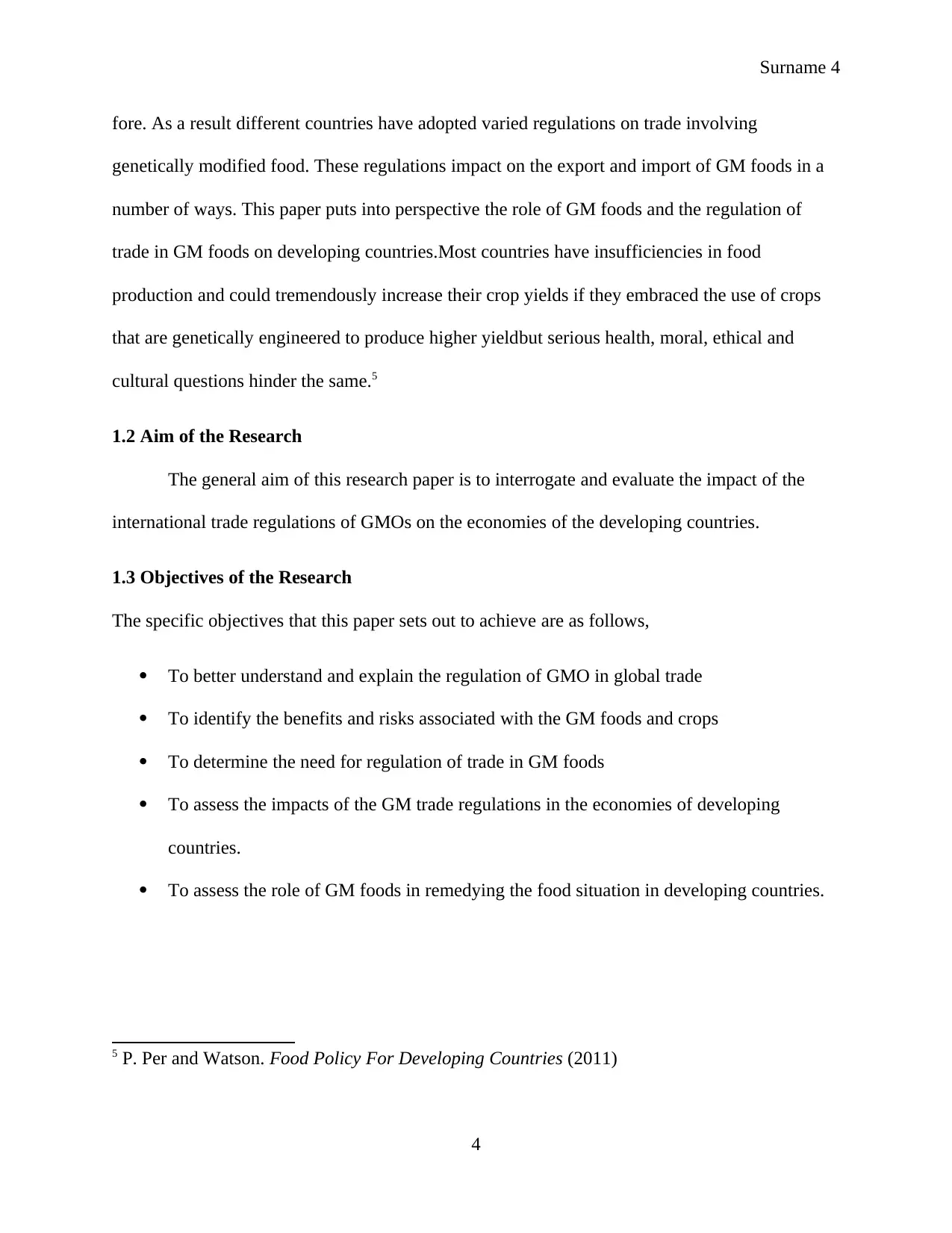
Surname 4
fore. As a result different countries have adopted varied regulations on trade involving
genetically modified food. These regulations impact on the export and import of GM foods in a
number of ways. This paper puts into perspective the role of GM foods and the regulation of
trade in GM foods on developing countries.Most countries have insufficiencies in food
production and could tremendously increase their crop yields if they embraced the use of crops
that are genetically engineered to produce higher yieldbut serious health, moral, ethical and
cultural questions hinder the same.5
1.2 Aim of the Research
The general aim of this research paper is to interrogate and evaluate the impact of the
international trade regulations of GMOs on the economies of the developing countries.
1.3 Objectives of the Research
The specific objectives that this paper sets out to achieve are as follows,
To better understand and explain the regulation of GMO in global trade
To identify the benefits and risks associated with the GM foods and crops
To determine the need for regulation of trade in GM foods
To assess the impacts of the GM trade regulations in the economies of developing
countries.
To assess the role of GM foods in remedying the food situation in developing countries.
5 P. Per and Watson. Food Policy For Developing Countries (2011)
4
fore. As a result different countries have adopted varied regulations on trade involving
genetically modified food. These regulations impact on the export and import of GM foods in a
number of ways. This paper puts into perspective the role of GM foods and the regulation of
trade in GM foods on developing countries.Most countries have insufficiencies in food
production and could tremendously increase their crop yields if they embraced the use of crops
that are genetically engineered to produce higher yieldbut serious health, moral, ethical and
cultural questions hinder the same.5
1.2 Aim of the Research
The general aim of this research paper is to interrogate and evaluate the impact of the
international trade regulations of GMOs on the economies of the developing countries.
1.3 Objectives of the Research
The specific objectives that this paper sets out to achieve are as follows,
To better understand and explain the regulation of GMO in global trade
To identify the benefits and risks associated with the GM foods and crops
To determine the need for regulation of trade in GM foods
To assess the impacts of the GM trade regulations in the economies of developing
countries.
To assess the role of GM foods in remedying the food situation in developing countries.
5 P. Per and Watson. Food Policy For Developing Countries (2011)
4
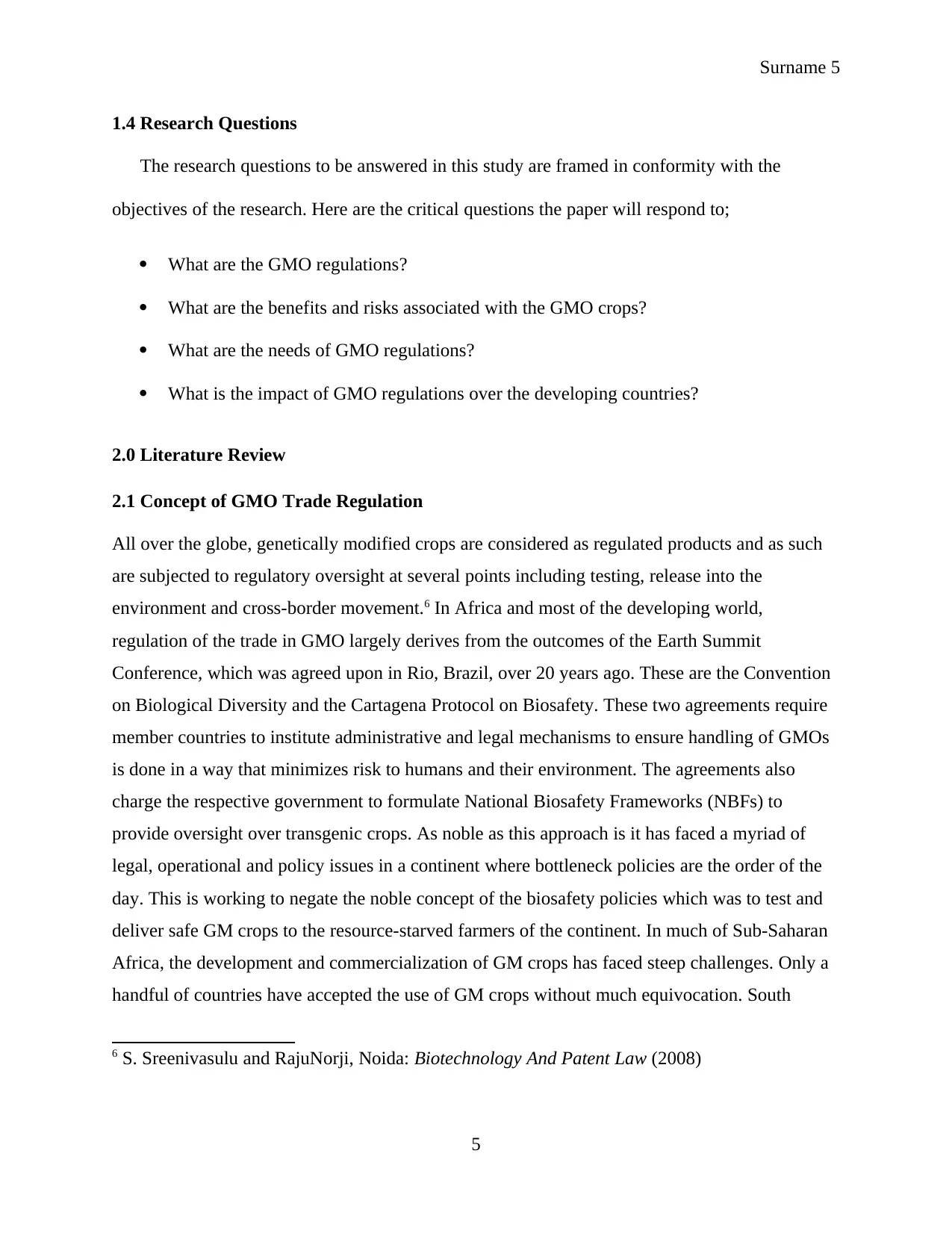
Surname 5
1.4 Research Questions
The research questions to be answered in this study are framed in conformity with the
objectives of the research. Here are the critical questions the paper will respond to;
What are the GMO regulations?
What are the benefits and risks associated with the GMO crops?
What are the needs of GMO regulations?
What is the impact of GMO regulations over the developing countries?
2.0 Literature Review
2.1 Concept of GMO Trade Regulation
All over the globe, genetically modified crops are considered as regulated products and as such
are subjected to regulatory oversight at several points including testing, release into the
environment and cross-border movement.6 In Africa and most of the developing world,
regulation of the trade in GMO largely derives from the outcomes of the Earth Summit
Conference, which was agreed upon in Rio, Brazil, over 20 years ago. These are the Convention
on Biological Diversity and the Cartagena Protocol on Biosafety. These two agreements require
member countries to institute administrative and legal mechanisms to ensure handling of GMOs
is done in a way that minimizes risk to humans and their environment. The agreements also
charge the respective government to formulate National Biosafety Frameworks (NBFs) to
provide oversight over transgenic crops. As noble as this approach is it has faced a myriad of
legal, operational and policy issues in a continent where bottleneck policies are the order of the
day. This is working to negate the noble concept of the biosafety policies which was to test and
deliver safe GM crops to the resource-starved farmers of the continent. In much of Sub-Saharan
Africa, the development and commercialization of GM crops has faced steep challenges. Only a
handful of countries have accepted the use of GM crops without much equivocation. South
6 S. Sreenivasulu and RajuNorji, Noida: Biotechnology And Patent Law (2008)
5
1.4 Research Questions
The research questions to be answered in this study are framed in conformity with the
objectives of the research. Here are the critical questions the paper will respond to;
What are the GMO regulations?
What are the benefits and risks associated with the GMO crops?
What are the needs of GMO regulations?
What is the impact of GMO regulations over the developing countries?
2.0 Literature Review
2.1 Concept of GMO Trade Regulation
All over the globe, genetically modified crops are considered as regulated products and as such
are subjected to regulatory oversight at several points including testing, release into the
environment and cross-border movement.6 In Africa and most of the developing world,
regulation of the trade in GMO largely derives from the outcomes of the Earth Summit
Conference, which was agreed upon in Rio, Brazil, over 20 years ago. These are the Convention
on Biological Diversity and the Cartagena Protocol on Biosafety. These two agreements require
member countries to institute administrative and legal mechanisms to ensure handling of GMOs
is done in a way that minimizes risk to humans and their environment. The agreements also
charge the respective government to formulate National Biosafety Frameworks (NBFs) to
provide oversight over transgenic crops. As noble as this approach is it has faced a myriad of
legal, operational and policy issues in a continent where bottleneck policies are the order of the
day. This is working to negate the noble concept of the biosafety policies which was to test and
deliver safe GM crops to the resource-starved farmers of the continent. In much of Sub-Saharan
Africa, the development and commercialization of GM crops has faced steep challenges. Only a
handful of countries have accepted the use of GM crops without much equivocation. South
6 S. Sreenivasulu and RajuNorji, Noida: Biotechnology And Patent Law (2008)
5
⊘ This is a preview!⊘
Do you want full access?
Subscribe today to unlock all pages.

Trusted by 1+ million students worldwide
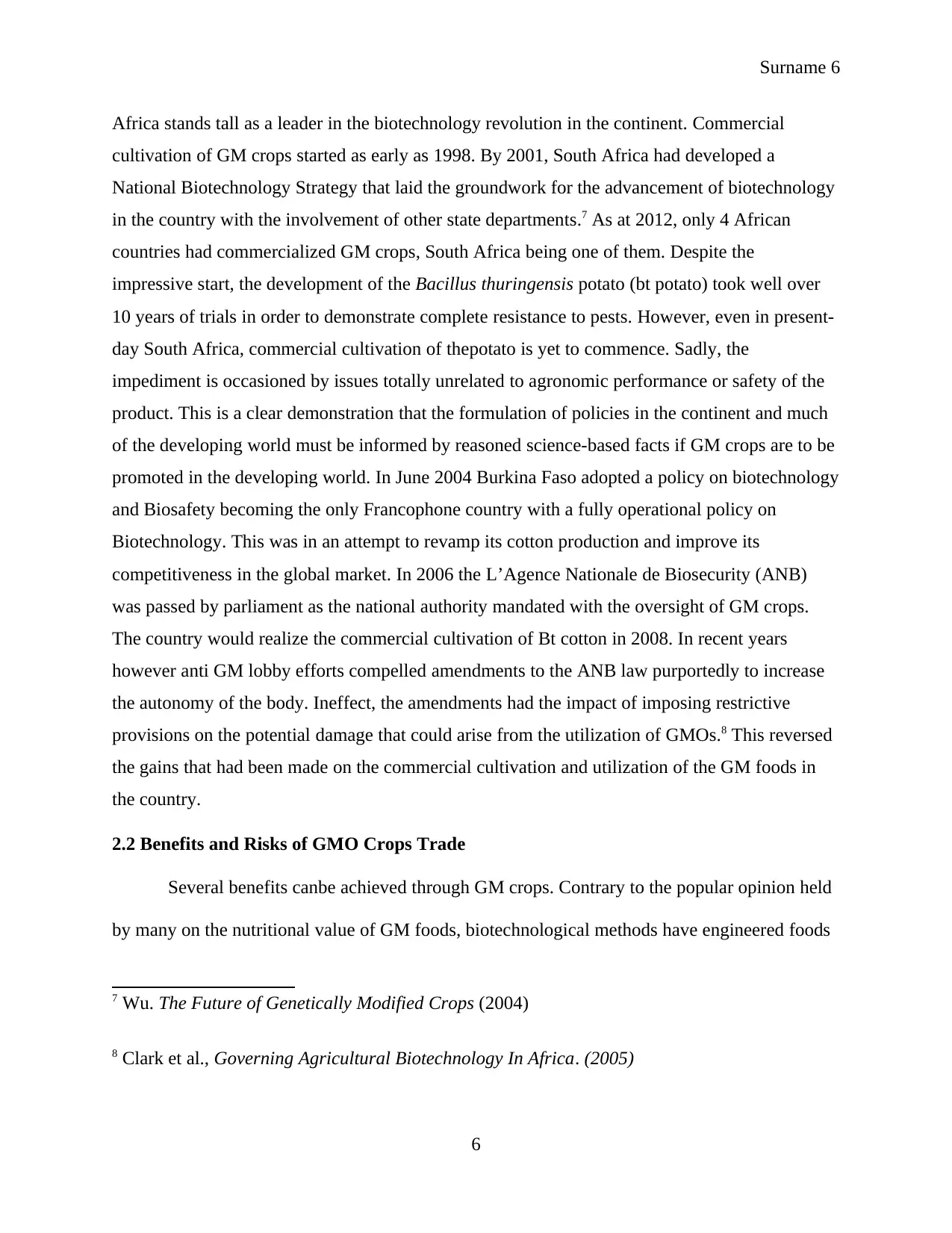
Surname 6
Africa stands tall as a leader in the biotechnology revolution in the continent. Commercial
cultivation of GM crops started as early as 1998. By 2001, South Africa had developed a
National Biotechnology Strategy that laid the groundwork for the advancement of biotechnology
in the country with the involvement of other state departments.7 As at 2012, only 4 African
countries had commercialized GM crops, South Africa being one of them. Despite the
impressive start, the development of the Bacillus thuringensis potato (bt potato) took well over
10 years of trials in order to demonstrate complete resistance to pests. However, even in present-
day South Africa, commercial cultivation of thepotato is yet to commence. Sadly, the
impediment is occasioned by issues totally unrelated to agronomic performance or safety of the
product. This is a clear demonstration that the formulation of policies in the continent and much
of the developing world must be informed by reasoned science-based facts if GM crops are to be
promoted in the developing world. In June 2004 Burkina Faso adopted a policy on biotechnology
and Biosafety becoming the only Francophone country with a fully operational policy on
Biotechnology. This was in an attempt to revamp its cotton production and improve its
competitiveness in the global market. In 2006 the L’Agence Nationale de Biosecurity (ANB)
was passed by parliament as the national authority mandated with the oversight of GM crops.
The country would realize the commercial cultivation of Bt cotton in 2008. In recent years
however anti GM lobby efforts compelled amendments to the ANB law purportedly to increase
the autonomy of the body. Ineffect, the amendments had the impact of imposing restrictive
provisions on the potential damage that could arise from the utilization of GMOs.8 This reversed
the gains that had been made on the commercial cultivation and utilization of the GM foods in
the country.
2.2 Benefits and Risks of GMO Crops Trade
Several benefits canbe achieved through GM crops. Contrary to the popular opinion held
by many on the nutritional value of GM foods, biotechnological methods have engineered foods
7 Wu. The Future of Genetically Modified Crops (2004)
8 Clark et al., Governing Agricultural Biotechnology In Africa. (2005)
6
Africa stands tall as a leader in the biotechnology revolution in the continent. Commercial
cultivation of GM crops started as early as 1998. By 2001, South Africa had developed a
National Biotechnology Strategy that laid the groundwork for the advancement of biotechnology
in the country with the involvement of other state departments.7 As at 2012, only 4 African
countries had commercialized GM crops, South Africa being one of them. Despite the
impressive start, the development of the Bacillus thuringensis potato (bt potato) took well over
10 years of trials in order to demonstrate complete resistance to pests. However, even in present-
day South Africa, commercial cultivation of thepotato is yet to commence. Sadly, the
impediment is occasioned by issues totally unrelated to agronomic performance or safety of the
product. This is a clear demonstration that the formulation of policies in the continent and much
of the developing world must be informed by reasoned science-based facts if GM crops are to be
promoted in the developing world. In June 2004 Burkina Faso adopted a policy on biotechnology
and Biosafety becoming the only Francophone country with a fully operational policy on
Biotechnology. This was in an attempt to revamp its cotton production and improve its
competitiveness in the global market. In 2006 the L’Agence Nationale de Biosecurity (ANB)
was passed by parliament as the national authority mandated with the oversight of GM crops.
The country would realize the commercial cultivation of Bt cotton in 2008. In recent years
however anti GM lobby efforts compelled amendments to the ANB law purportedly to increase
the autonomy of the body. Ineffect, the amendments had the impact of imposing restrictive
provisions on the potential damage that could arise from the utilization of GMOs.8 This reversed
the gains that had been made on the commercial cultivation and utilization of the GM foods in
the country.
2.2 Benefits and Risks of GMO Crops Trade
Several benefits canbe achieved through GM crops. Contrary to the popular opinion held
by many on the nutritional value of GM foods, biotechnological methods have engineered foods
7 Wu. The Future of Genetically Modified Crops (2004)
8 Clark et al., Governing Agricultural Biotechnology In Africa. (2005)
6
Paraphrase This Document
Need a fresh take? Get an instant paraphrase of this document with our AI Paraphraser
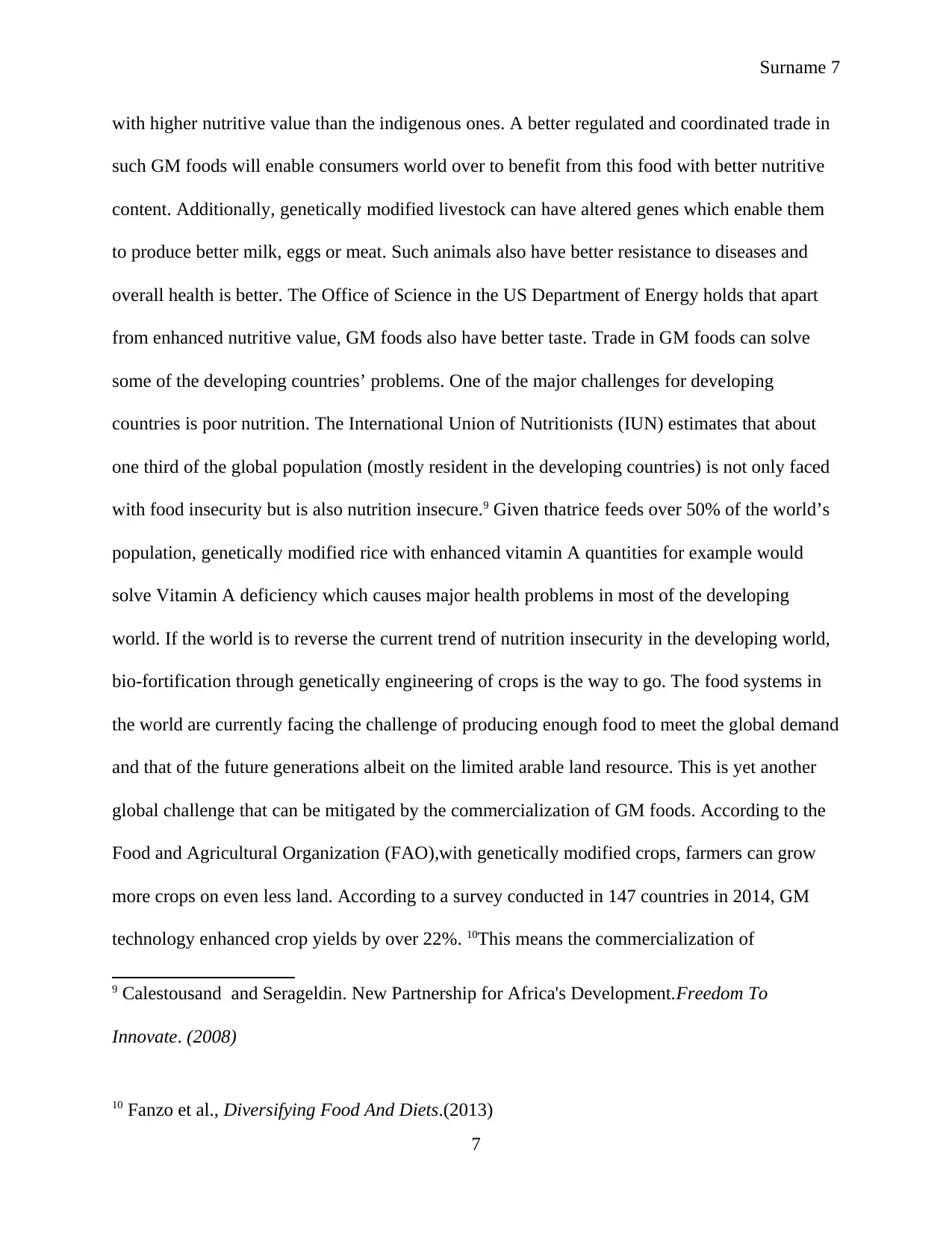
Surname 7
with higher nutritive value than the indigenous ones. A better regulated and coordinated trade in
such GM foods will enable consumers world over to benefit from this food with better nutritive
content. Additionally, genetically modified livestock can have altered genes which enable them
to produce better milk, eggs or meat. Such animals also have better resistance to diseases and
overall health is better. The Office of Science in the US Department of Energy holds that apart
from enhanced nutritive value, GM foods also have better taste. Trade in GM foods can solve
some of the developing countries’ problems. One of the major challenges for developing
countries is poor nutrition. The International Union of Nutritionists (IUN) estimates that about
one third of the global population (mostly resident in the developing countries) is not only faced
with food insecurity but is also nutrition insecure.9 Given thatrice feeds over 50% of the world’s
population, genetically modified rice with enhanced vitamin A quantities for example would
solve Vitamin A deficiency which causes major health problems in most of the developing
world. If the world is to reverse the current trend of nutrition insecurity in the developing world,
bio-fortification through genetically engineering of crops is the way to go. The food systems in
the world are currently facing the challenge of producing enough food to meet the global demand
and that of the future generations albeit on the limited arable land resource. This is yet another
global challenge that can be mitigated by the commercialization of GM foods. According to the
Food and Agricultural Organization (FAO),with genetically modified crops, farmers can grow
more crops on even less land. According to a survey conducted in 147 countries in 2014, GM
technology enhanced crop yields by over 22%. 10This means the commercialization of
9 Calestousand and Serageldin. New Partnership for Africa's Development.Freedom To
Innovate. (2008)
10 Fanzo et al., Diversifying Food And Diets.(2013)
7
with higher nutritive value than the indigenous ones. A better regulated and coordinated trade in
such GM foods will enable consumers world over to benefit from this food with better nutritive
content. Additionally, genetically modified livestock can have altered genes which enable them
to produce better milk, eggs or meat. Such animals also have better resistance to diseases and
overall health is better. The Office of Science in the US Department of Energy holds that apart
from enhanced nutritive value, GM foods also have better taste. Trade in GM foods can solve
some of the developing countries’ problems. One of the major challenges for developing
countries is poor nutrition. The International Union of Nutritionists (IUN) estimates that about
one third of the global population (mostly resident in the developing countries) is not only faced
with food insecurity but is also nutrition insecure.9 Given thatrice feeds over 50% of the world’s
population, genetically modified rice with enhanced vitamin A quantities for example would
solve Vitamin A deficiency which causes major health problems in most of the developing
world. If the world is to reverse the current trend of nutrition insecurity in the developing world,
bio-fortification through genetically engineering of crops is the way to go. The food systems in
the world are currently facing the challenge of producing enough food to meet the global demand
and that of the future generations albeit on the limited arable land resource. This is yet another
global challenge that can be mitigated by the commercialization of GM foods. According to the
Food and Agricultural Organization (FAO),with genetically modified crops, farmers can grow
more crops on even less land. According to a survey conducted in 147 countries in 2014, GM
technology enhanced crop yields by over 22%. 10This means the commercialization of
9 Calestousand and Serageldin. New Partnership for Africa's Development.Freedom To
Innovate. (2008)
10 Fanzo et al., Diversifying Food And Diets.(2013)
7
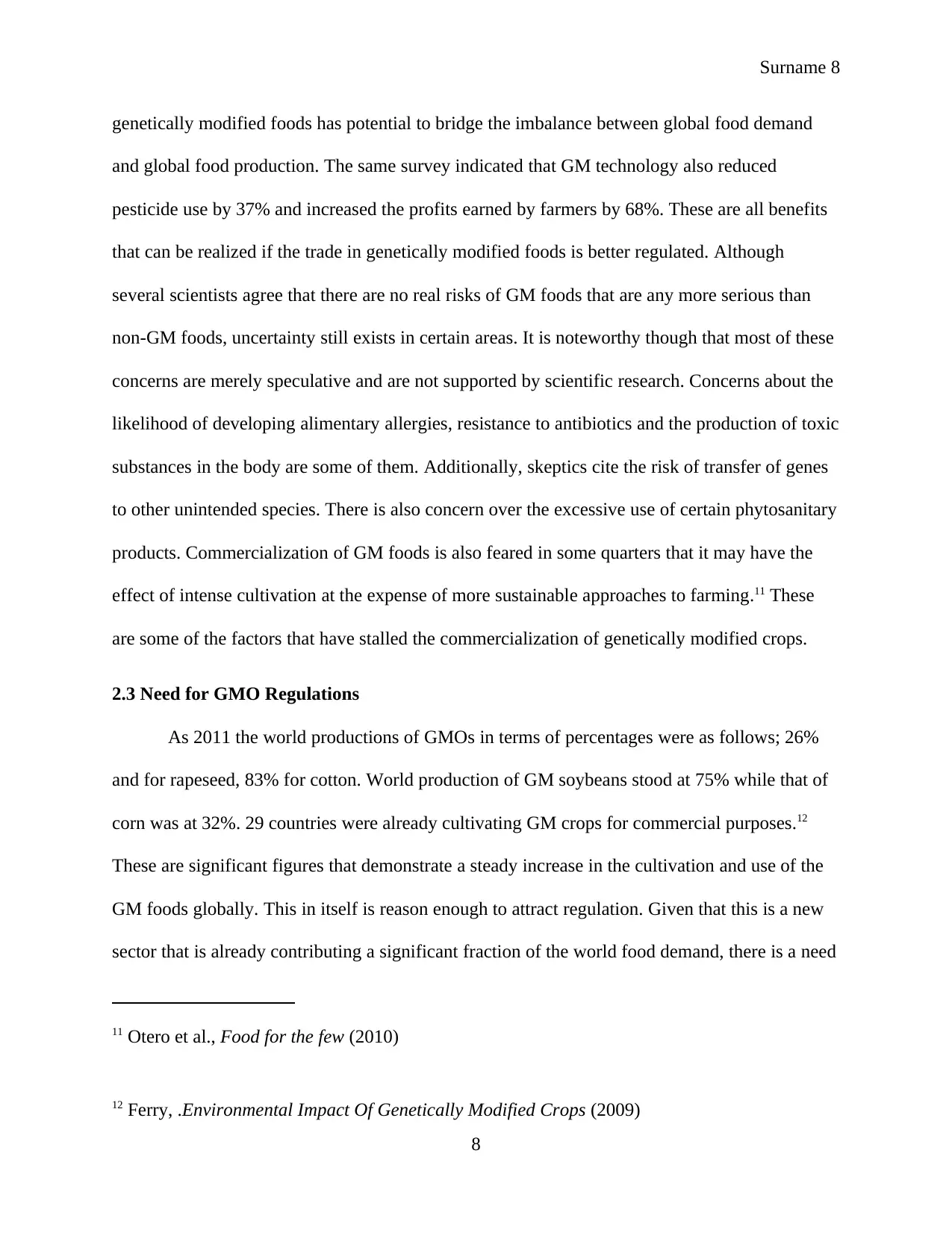
Surname 8
genetically modified foods has potential to bridge the imbalance between global food demand
and global food production. The same survey indicated that GM technology also reduced
pesticide use by 37% and increased the profits earned by farmers by 68%. These are all benefits
that can be realized if the trade in genetically modified foods is better regulated. Although
several scientists agree that there are no real risks of GM foods that are any more serious than
non-GM foods, uncertainty still exists in certain areas. It is noteworthy though that most of these
concerns are merely speculative and are not supported by scientific research. Concerns about the
likelihood of developing alimentary allergies, resistance to antibiotics and the production of toxic
substances in the body are some of them. Additionally, skeptics cite the risk of transfer of genes
to other unintended species. There is also concern over the excessive use of certain phytosanitary
products. Commercialization of GM foods is also feared in some quarters that it may have the
effect of intense cultivation at the expense of more sustainable approaches to farming.11 These
are some of the factors that have stalled the commercialization of genetically modified crops.
2.3 Need for GMO Regulations
As 2011 the world productions of GMOs in terms of percentages were as follows; 26%
and for rapeseed, 83% for cotton. World production of GM soybeans stood at 75% while that of
corn was at 32%. 29 countries were already cultivating GM crops for commercial purposes.12
These are significant figures that demonstrate a steady increase in the cultivation and use of the
GM foods globally. This in itself is reason enough to attract regulation. Given that this is a new
sector that is already contributing a significant fraction of the world food demand, there is a need
11 Otero et al., Food for the few (2010)
12 Ferry, .Environmental Impact Of Genetically Modified Crops (2009)
8
genetically modified foods has potential to bridge the imbalance between global food demand
and global food production. The same survey indicated that GM technology also reduced
pesticide use by 37% and increased the profits earned by farmers by 68%. These are all benefits
that can be realized if the trade in genetically modified foods is better regulated. Although
several scientists agree that there are no real risks of GM foods that are any more serious than
non-GM foods, uncertainty still exists in certain areas. It is noteworthy though that most of these
concerns are merely speculative and are not supported by scientific research. Concerns about the
likelihood of developing alimentary allergies, resistance to antibiotics and the production of toxic
substances in the body are some of them. Additionally, skeptics cite the risk of transfer of genes
to other unintended species. There is also concern over the excessive use of certain phytosanitary
products. Commercialization of GM foods is also feared in some quarters that it may have the
effect of intense cultivation at the expense of more sustainable approaches to farming.11 These
are some of the factors that have stalled the commercialization of genetically modified crops.
2.3 Need for GMO Regulations
As 2011 the world productions of GMOs in terms of percentages were as follows; 26%
and for rapeseed, 83% for cotton. World production of GM soybeans stood at 75% while that of
corn was at 32%. 29 countries were already cultivating GM crops for commercial purposes.12
These are significant figures that demonstrate a steady increase in the cultivation and use of the
GM foods globally. This in itself is reason enough to attract regulation. Given that this is a new
sector that is already contributing a significant fraction of the world food demand, there is a need
11 Otero et al., Food for the few (2010)
12 Ferry, .Environmental Impact Of Genetically Modified Crops (2009)
8
⊘ This is a preview!⊘
Do you want full access?
Subscribe today to unlock all pages.

Trusted by 1+ million students worldwide
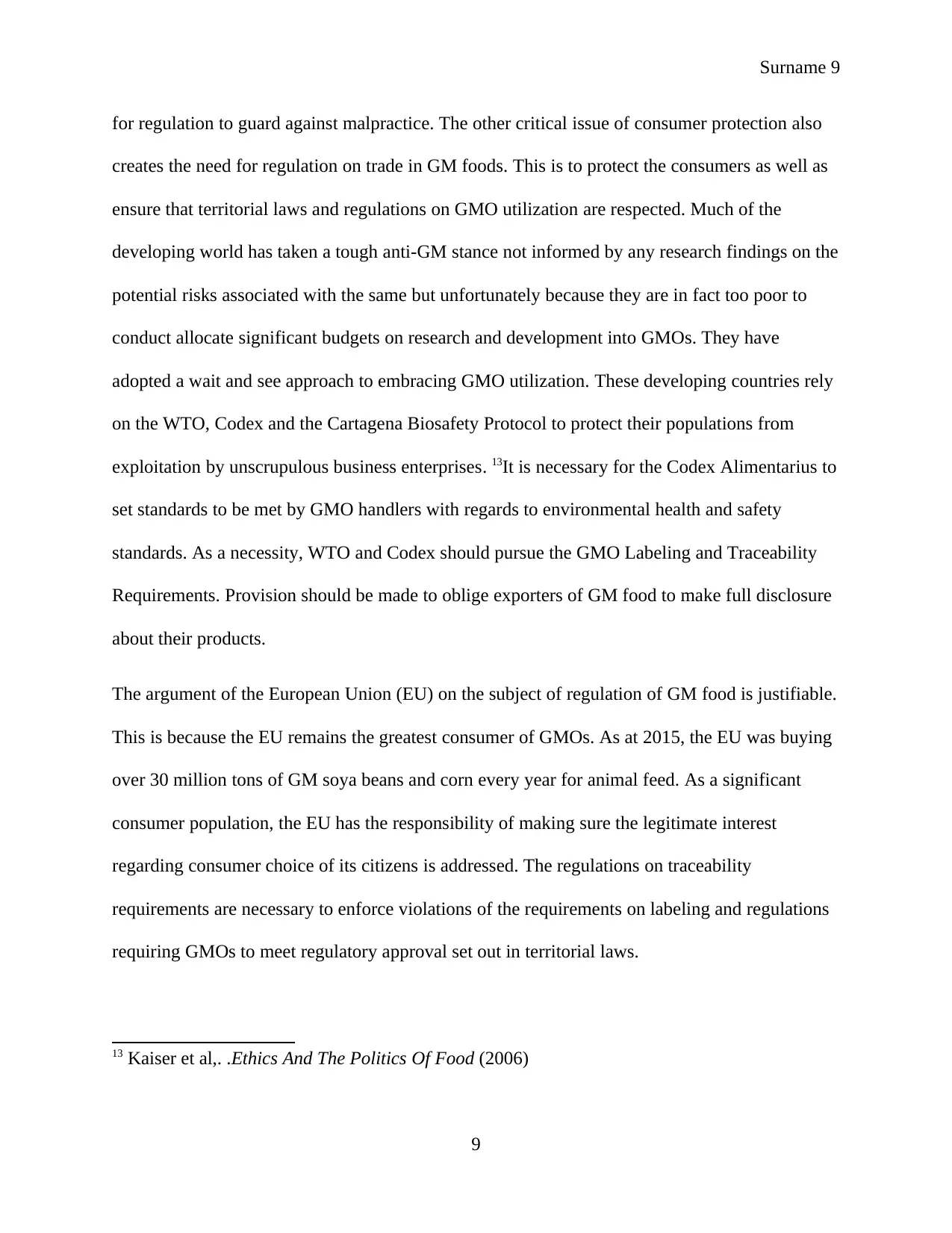
Surname 9
for regulation to guard against malpractice. The other critical issue of consumer protection also
creates the need for regulation on trade in GM foods. This is to protect the consumers as well as
ensure that territorial laws and regulations on GMO utilization are respected. Much of the
developing world has taken a tough anti-GM stance not informed by any research findings on the
potential risks associated with the same but unfortunately because they are in fact too poor to
conduct allocate significant budgets on research and development into GMOs. They have
adopted a wait and see approach to embracing GMO utilization. These developing countries rely
on the WTO, Codex and the Cartagena Biosafety Protocol to protect their populations from
exploitation by unscrupulous business enterprises. 13It is necessary for the Codex Alimentarius to
set standards to be met by GMO handlers with regards to environmental health and safety
standards. As a necessity, WTO and Codex should pursue the GMO Labeling and Traceability
Requirements. Provision should be made to oblige exporters of GM food to make full disclosure
about their products.
The argument of the European Union (EU) on the subject of regulation of GM food is justifiable.
This is because the EU remains the greatest consumer of GMOs. As at 2015, the EU was buying
over 30 million tons of GM soya beans and corn every year for animal feed. As a significant
consumer population, the EU has the responsibility of making sure the legitimate interest
regarding consumer choice of its citizens is addressed. The regulations on traceability
requirements are necessary to enforce violations of the requirements on labeling and regulations
requiring GMOs to meet regulatory approval set out in territorial laws.
13 Kaiser et al,. .Ethics And The Politics Of Food (2006)
9
for regulation to guard against malpractice. The other critical issue of consumer protection also
creates the need for regulation on trade in GM foods. This is to protect the consumers as well as
ensure that territorial laws and regulations on GMO utilization are respected. Much of the
developing world has taken a tough anti-GM stance not informed by any research findings on the
potential risks associated with the same but unfortunately because they are in fact too poor to
conduct allocate significant budgets on research and development into GMOs. They have
adopted a wait and see approach to embracing GMO utilization. These developing countries rely
on the WTO, Codex and the Cartagena Biosafety Protocol to protect their populations from
exploitation by unscrupulous business enterprises. 13It is necessary for the Codex Alimentarius to
set standards to be met by GMO handlers with regards to environmental health and safety
standards. As a necessity, WTO and Codex should pursue the GMO Labeling and Traceability
Requirements. Provision should be made to oblige exporters of GM food to make full disclosure
about their products.
The argument of the European Union (EU) on the subject of regulation of GM food is justifiable.
This is because the EU remains the greatest consumer of GMOs. As at 2015, the EU was buying
over 30 million tons of GM soya beans and corn every year for animal feed. As a significant
consumer population, the EU has the responsibility of making sure the legitimate interest
regarding consumer choice of its citizens is addressed. The regulations on traceability
requirements are necessary to enforce violations of the requirements on labeling and regulations
requiring GMOs to meet regulatory approval set out in territorial laws.
13 Kaiser et al,. .Ethics And The Politics Of Food (2006)
9
Paraphrase This Document
Need a fresh take? Get an instant paraphrase of this document with our AI Paraphraser
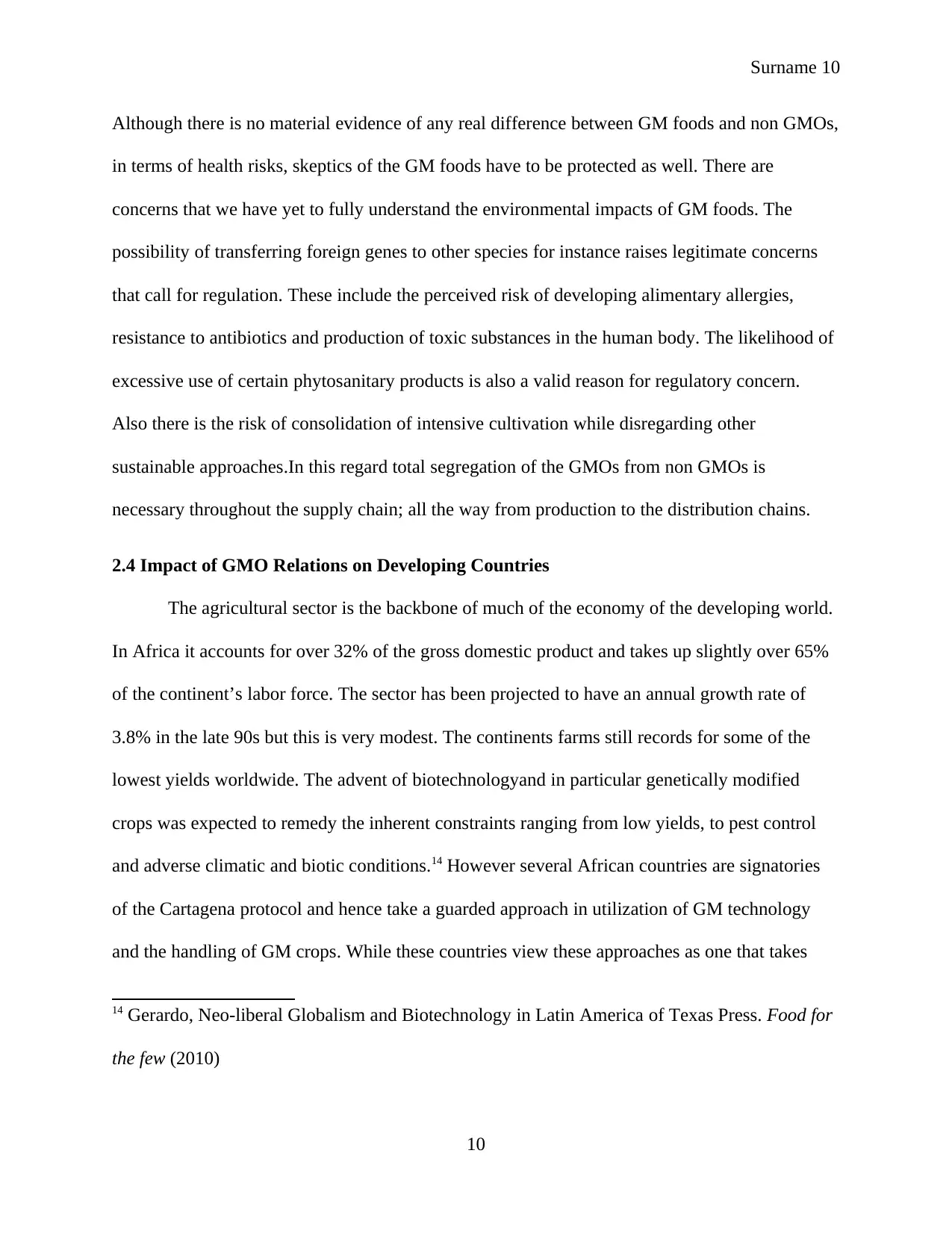
Surname 10
Although there is no material evidence of any real difference between GM foods and non GMOs,
in terms of health risks, skeptics of the GM foods have to be protected as well. There are
concerns that we have yet to fully understand the environmental impacts of GM foods. The
possibility of transferring foreign genes to other species for instance raises legitimate concerns
that call for regulation. These include the perceived risk of developing alimentary allergies,
resistance to antibiotics and production of toxic substances in the human body. The likelihood of
excessive use of certain phytosanitary products is also a valid reason for regulatory concern.
Also there is the risk of consolidation of intensive cultivation while disregarding other
sustainable approaches.In this regard total segregation of the GMOs from non GMOs is
necessary throughout the supply chain; all the way from production to the distribution chains.
2.4 Impact of GMO Relations on Developing Countries
The agricultural sector is the backbone of much of the economy of the developing world.
In Africa it accounts for over 32% of the gross domestic product and takes up slightly over 65%
of the continent’s labor force. The sector has been projected to have an annual growth rate of
3.8% in the late 90s but this is very modest. The continents farms still records for some of the
lowest yields worldwide. The advent of biotechnologyand in particular genetically modified
crops was expected to remedy the inherent constraints ranging from low yields, to pest control
and adverse climatic and biotic conditions.14 However several African countries are signatories
of the Cartagena protocol and hence take a guarded approach in utilization of GM technology
and the handling of GM crops. While these countries view these approaches as one that takes
14 Gerardo, Neo-liberal Globalism and Biotechnology in Latin America of Texas Press. Food for
the few (2010)
10
Although there is no material evidence of any real difference between GM foods and non GMOs,
in terms of health risks, skeptics of the GM foods have to be protected as well. There are
concerns that we have yet to fully understand the environmental impacts of GM foods. The
possibility of transferring foreign genes to other species for instance raises legitimate concerns
that call for regulation. These include the perceived risk of developing alimentary allergies,
resistance to antibiotics and production of toxic substances in the human body. The likelihood of
excessive use of certain phytosanitary products is also a valid reason for regulatory concern.
Also there is the risk of consolidation of intensive cultivation while disregarding other
sustainable approaches.In this regard total segregation of the GMOs from non GMOs is
necessary throughout the supply chain; all the way from production to the distribution chains.
2.4 Impact of GMO Relations on Developing Countries
The agricultural sector is the backbone of much of the economy of the developing world.
In Africa it accounts for over 32% of the gross domestic product and takes up slightly over 65%
of the continent’s labor force. The sector has been projected to have an annual growth rate of
3.8% in the late 90s but this is very modest. The continents farms still records for some of the
lowest yields worldwide. The advent of biotechnologyand in particular genetically modified
crops was expected to remedy the inherent constraints ranging from low yields, to pest control
and adverse climatic and biotic conditions.14 However several African countries are signatories
of the Cartagena protocol and hence take a guarded approach in utilization of GM technology
and the handling of GM crops. While these countries view these approaches as one that takes
14 Gerardo, Neo-liberal Globalism and Biotechnology in Latin America of Texas Press. Food for
the few (2010)
10
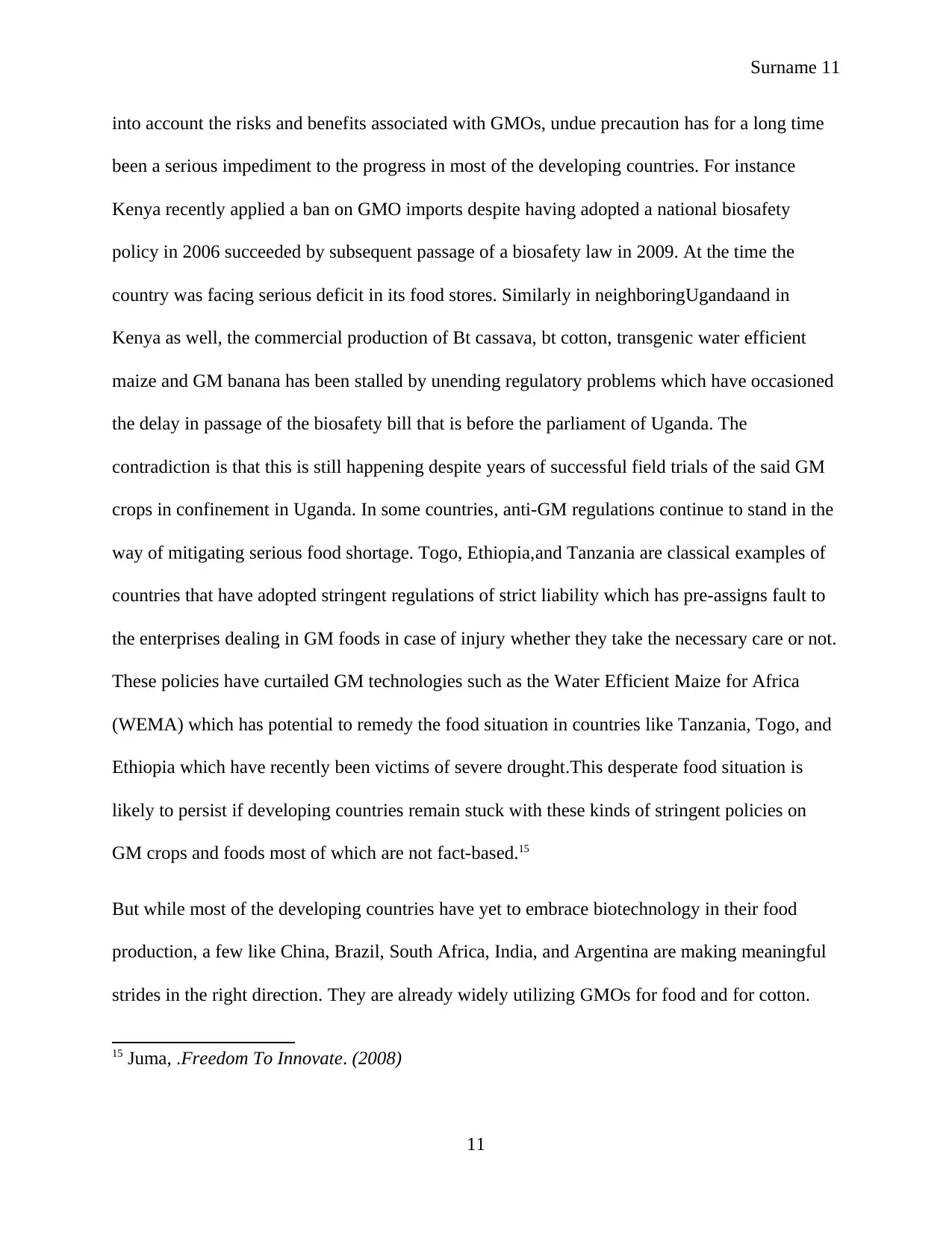
Surname 11
into account the risks and benefits associated with GMOs, undue precaution has for a long time
been a serious impediment to the progress in most of the developing countries. For instance
Kenya recently applied a ban on GMO imports despite having adopted a national biosafety
policy in 2006 succeeded by subsequent passage of a biosafety law in 2009. At the time the
country was facing serious deficit in its food stores. Similarly in neighboringUgandaand in
Kenya as well, the commercial production of Bt cassava, bt cotton, transgenic water efficient
maize and GM banana has been stalled by unending regulatory problems which have occasioned
the delay in passage of the biosafety bill that is before the parliament of Uganda. The
contradiction is that this is still happening despite years of successful field trials of the said GM
crops in confinement in Uganda. In some countries, anti-GM regulations continue to stand in the
way of mitigating serious food shortage. Togo, Ethiopia,and Tanzania are classical examples of
countries that have adopted stringent regulations of strict liability which has pre-assigns fault to
the enterprises dealing in GM foods in case of injury whether they take the necessary care or not.
These policies have curtailed GM technologies such as the Water Efficient Maize for Africa
(WEMA) which has potential to remedy the food situation in countries like Tanzania, Togo, and
Ethiopia which have recently been victims of severe drought.This desperate food situation is
likely to persist if developing countries remain stuck with these kinds of stringent policies on
GM crops and foods most of which are not fact-based.15
But while most of the developing countries have yet to embrace biotechnology in their food
production, a few like China, Brazil, South Africa, India, and Argentina are making meaningful
strides in the right direction. They are already widely utilizing GMOs for food and for cotton.
15 Juma, .Freedom To Innovate. (2008)
11
into account the risks and benefits associated with GMOs, undue precaution has for a long time
been a serious impediment to the progress in most of the developing countries. For instance
Kenya recently applied a ban on GMO imports despite having adopted a national biosafety
policy in 2006 succeeded by subsequent passage of a biosafety law in 2009. At the time the
country was facing serious deficit in its food stores. Similarly in neighboringUgandaand in
Kenya as well, the commercial production of Bt cassava, bt cotton, transgenic water efficient
maize and GM banana has been stalled by unending regulatory problems which have occasioned
the delay in passage of the biosafety bill that is before the parliament of Uganda. The
contradiction is that this is still happening despite years of successful field trials of the said GM
crops in confinement in Uganda. In some countries, anti-GM regulations continue to stand in the
way of mitigating serious food shortage. Togo, Ethiopia,and Tanzania are classical examples of
countries that have adopted stringent regulations of strict liability which has pre-assigns fault to
the enterprises dealing in GM foods in case of injury whether they take the necessary care or not.
These policies have curtailed GM technologies such as the Water Efficient Maize for Africa
(WEMA) which has potential to remedy the food situation in countries like Tanzania, Togo, and
Ethiopia which have recently been victims of severe drought.This desperate food situation is
likely to persist if developing countries remain stuck with these kinds of stringent policies on
GM crops and foods most of which are not fact-based.15
But while most of the developing countries have yet to embrace biotechnology in their food
production, a few like China, Brazil, South Africa, India, and Argentina are making meaningful
strides in the right direction. They are already widely utilizing GMOs for food and for cotton.
15 Juma, .Freedom To Innovate. (2008)
11
⊘ This is a preview!⊘
Do you want full access?
Subscribe today to unlock all pages.

Trusted by 1+ million students worldwide
1 out of 18
Your All-in-One AI-Powered Toolkit for Academic Success.
+13062052269
info@desklib.com
Available 24*7 on WhatsApp / Email
![[object Object]](/_next/static/media/star-bottom.7253800d.svg)
Unlock your academic potential
Copyright © 2020–2025 A2Z Services. All Rights Reserved. Developed and managed by ZUCOL.


